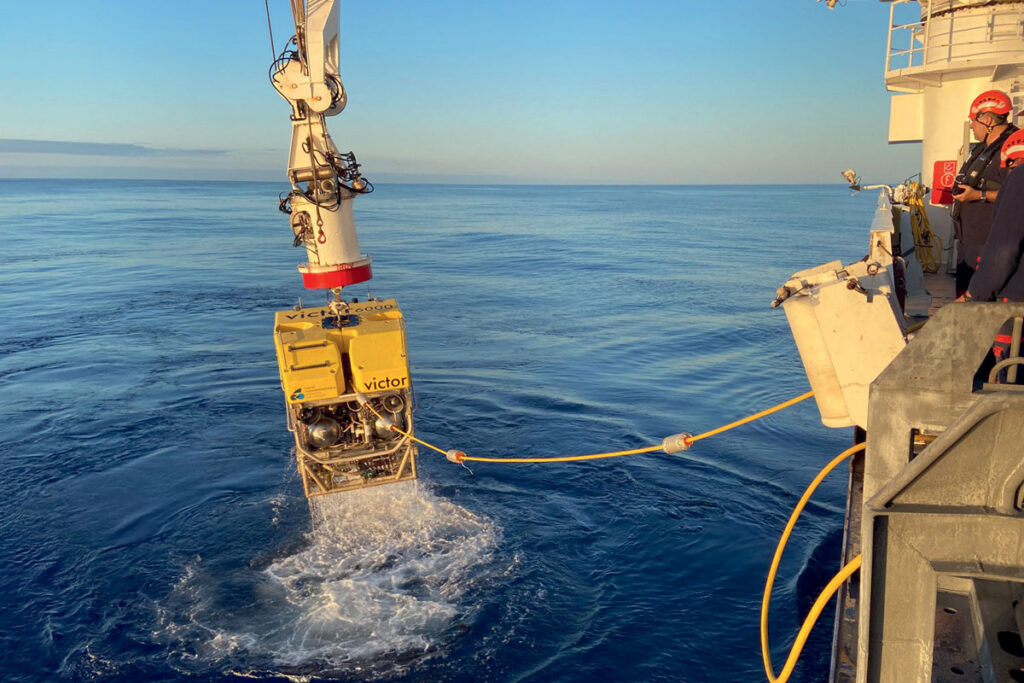[LUM#18] Under the oceans, the Earth
What if the Earth's manufacturing secrets lay beneath the sea? Last May, geologist Benoît Ildefonse took part in the Arc-en-Sub campaign organized by the French oceanographic fleet. Destination Rainbow, an underwater dome formed on the Atlantic ridge, the dynamics of which still elude researchers.

" In marine geology, we work on the oceans but without the water, because what interests us is what's underneath. And to find out once again "what' s underneath ", Benoît Ildefonse took part in the Arc-en-Sub campaign last May. 26 days at sea aboard Pourquoi pas? one of the four ships in the French ocean fleet. " There were around twenty scientists on board: geophysicists, petrologists, people interested in rocks , others geophysicists, petrologists, people interested in rocks, others in earthquakes, but only geologists," says the director of Géoscience Montpellier, who can't count the number of campaigns carried out at sea since the very first one in 1997.
And for this mission, we're heading for the Rainbow massif, an underwater dome culminating at 1,500 metres below sea level, located on the Atlantic ridge two days' sailing west of the Azores. "Oceanic ridges are a 60,000-kilometre-long chain of mainly volcanic mountains, located at depths of between 1,000 and 4,000 metres, which correspond to the boundaries of tectonic plates," explains the geologist. Plates that can clash or move apart at speeds ranging from one centimeter per year for the slowest, such as the Atlantic ridge, to fifteen centimeters per year for the fastest, in the eastern Pacific.
A crust factory
Veritable factories for building the Earth's crust thanks to the magma escaping from their faults, ridges are also zones of intense hydrothermal activity. Cold ocean water slips into the faults and, on contact with the magma, heats up to several hundred degrees," continues Benoît Ildefonse. When this water, which has picked up a number of chemical elements along the way, reaches supercritical conditions, it rises and emerges in the form of plumes. These plumes precipitate minerals such as manganese and iron sulfides when they come into contact with colder seawater of a different chemical composition.
In addition to the unique biodiversity they harbor and the deposits of precious minerals they contain, these ridges play a vital role in cooling the planet. " It is estimated that the entire volume of the ocean is recycled in this circulation more than 100 times in 80 million years. In a single day, that's more than 1 million Olympic-sized swimming pools or 45 Salagou lakes.
Although the Rainbow site has been known for 25 years, scientists have yet to fully understand how it works, hence this latest mission. " The topography of the site is more in line with that of an area with little volcanic activity, yet we are seeing hydrothermal activity, which implies the presence of pockets of magma underneath, but we don't know exactly where they are ," sums up the researcher. In addition, the scientists discovered an older low-temperature site with different rocks in the vicinity of this high-temperature site. " This therefore indicates geographical and temporal variability in this system, and this campaign aimed to explore this complexity."
Change of scale
To achieve this, the geologists brought up more than 320 rock samples from the depths of the sea and shot almost 200 hours of video. Victor, a remotely operated submarine, and IdefX, an autonomous underwater vehicle, were also used to produce a micro-bathymetric map of the area to a scale of a few centimetres, as well as systematic photographic coverage of the seabed. " This detailed mapping revealed some extraordinary things. The exploitation of the data and samples will now enable us to resituate all this in a complete integrated scheme associating magmatism, hydrothermalism and tectonics," enthuses Benoît Ildefonse.
Since their return from the mission, the scientists have been making the samples speak in the language of their own specialties: chemical composition and variability, mineralogical changes linked to reactions with hydrothermal fluids... For his part, the Montpellier geologist is interested in their deformation by measuring the orientation of crystals using an electron microscope on 30-micron-thick slides. " These microstructures give us an indication of the temperature at which these rocks were deformed," explains Benoît Ildefonse, before concluding: " In geology, we often work on a very small scale to understand dynamics that occur on a very large scale.
At sea with FOF
" The French Oceanographic Fleet (FOF) is a tool that I know well," explains Benoît Ildefonse, Director of Géoscience Montpellier. In the French scientific landscape, it's what we call a very large research infrastructure, like the Soleil synchrotron or certain telescopes ". In 2000, he climbed aboard the Atalante for the first time, one of the four FOF deep-sea vessels operating under the direction ofIfremer, CNRS,IRD and the network of French marine universities to which the University of Montpellier belongs. For the past 4 years, Benoît Ildefonse has chaired FOF's National Offshore Fleet Commission, helping to select and evaluate the various campaigns carried out. " I love being at sea. I love the routine that settles in, the shift work, especially the 4/8 (4h-8h/16h-20h) because you get to see the sunrise and sunset. Campaigns at sea are always extraordinary human adventures.
UM podcasts are now available on your favorite platforms (Spotify, Deezer, Apple podcasts, Amazon Music...).